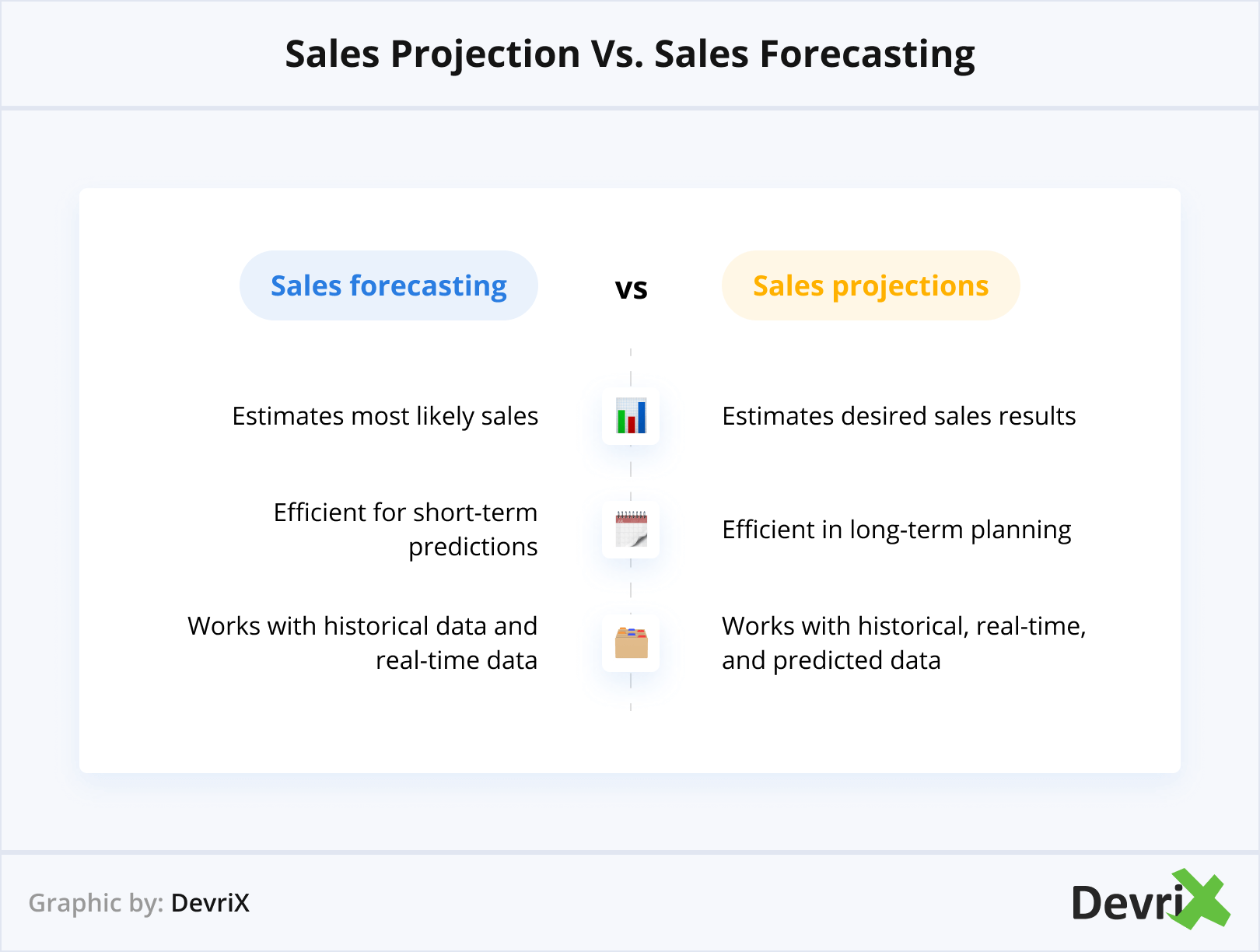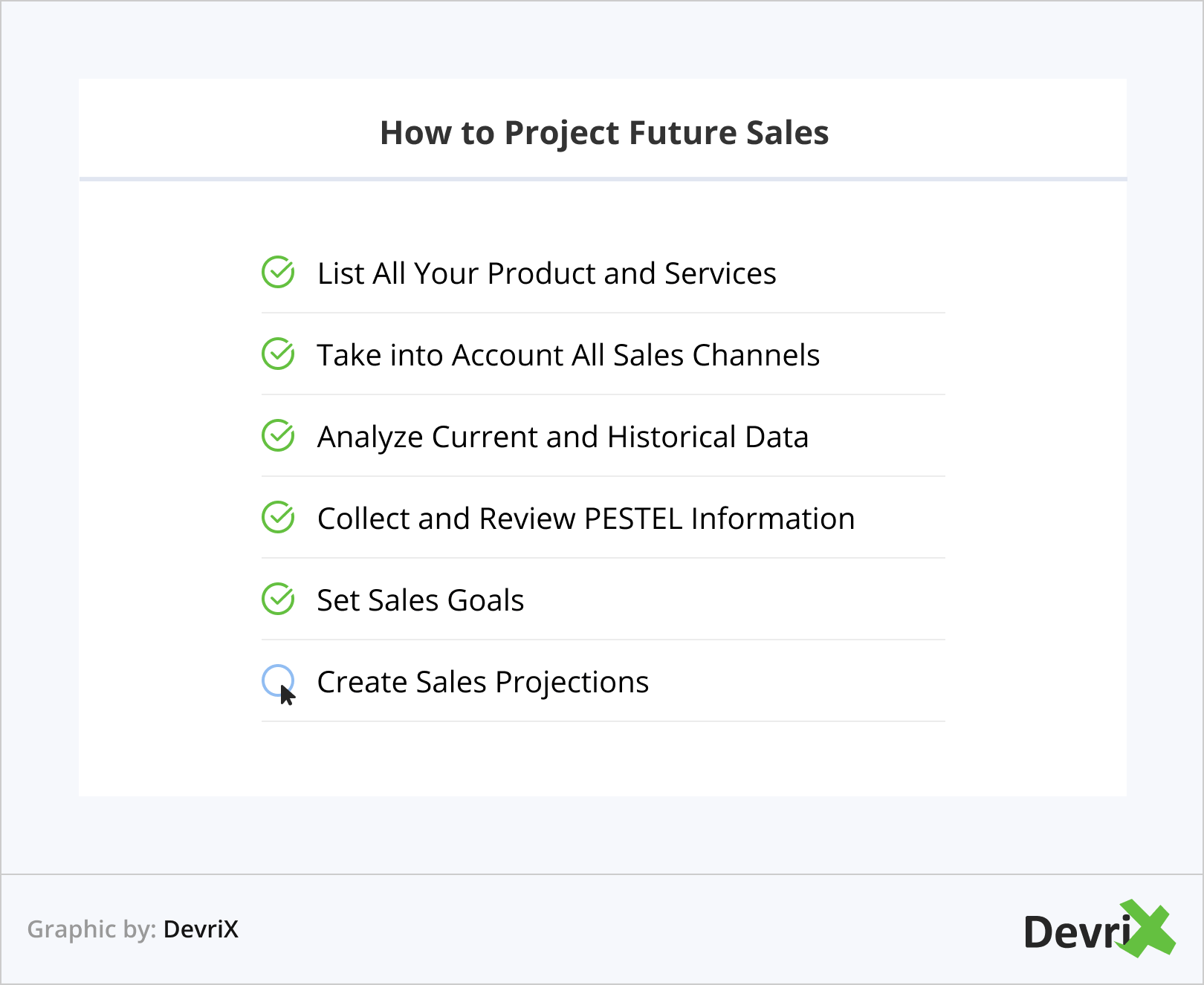Planning is the foundation of business success. If you want to conquer the market, grow your endeavor, and stay ahead of the competition, you need to work hard and offer a great product.
However, if you want your company to stand the test of time, you also need to establish your goals.
While none of us can see what tomorrow holds, there are business techniques that allow us to map out a path toward our success and start building the future that we desire today.
In this article, we talk about one such tool – sales projection – and explain how to leverage it and benefit from it.
Read on and take notes!
What Are Sales Projections?

A sales projection is an estimation that businesses make in order to foresee and plan future sales and revenue.
Depending on whether the company is an already established one or a startup, the data used to build a projection can be derived from in-house historical records or industry resources and analysis.
Based on this information, the business can devise a course of development for a set period of time, taking into consideration all the factors that affect it, and setting goals and KPIs to streamline its implementation.
In layman’s terms, a sales projection is the “where do you see yourself in 5 years” equivalent of a company’s sales and revenue objectives.
Sales Projection Vs. Sales Forecasting
The terms sales projection and sales forecasting are often used interchangeably. While they have a lot in common, they are two different things.

Sales Projection Vs. Sales Forecasting
Sales forecasting
- Estimates most likely sales
- Efficient for short-term predictions
- Works with historical data and real-time data
Sales projections
- Estimates desired sales results
- Efficient in long-term planning
- Works with historical, real-time, and predicted data
Sales forecasting uses real-life and historical data to calculate and predict realistic sales numbers that can be achieved in the foreseeable future.
It’s a technique that businesses use to plan their budgeting, revenue, and finances for short periods of time, such as a quarter or a year, based on current information and factors that are more or less in their control.
While sales forecasts are, more often than not, accurate and efficient, as time passes, too many of the relevant factors they rely on become unstable and difficult to foresee. And this reduces their dependability.
Sales projections include large-scale future planning and focus more on the sales the business wants to achieve, rather than those that the hard data show.
In other words, when they are conducting sales projections, companies set sales goals that they desire to achieve in the long run, and reverse-engineer how it can be done.
Why Are Sales Projections Important?
Sales projections are used in financial and strategic planning to measure the success of a business and its growth and development potential. They can also be used in risk assessment, investor hunting, talent acquisition, and resources management.
Here’s how you can leverage them in your business:
- Strategize your organization’s development. By estimating future sales and what is required to achieve them, you can plan and strategize growth. The data can help your decision-making process and, potentially, reduce the risks of failure.
- Device new business models. Based on your product’s specifications and the market demand trends, you can construct business models that will facilitate your desired sales figures.
- Plan resources over long periods of time. With the data from the sales projections, you can calculate the resources needed for your business to grow and develop. This includes financing, budgets, manpower, supplies, organizational expenses, and everything else your business needs.
- Attract new investors and financial support. With a clear plan for the future and data-backed sales projections, you can foresee the financial support you need in terms of loans and investments. Furthermore, you can use the information to justify your needs to stakeholders and plan your finances.
How to Project Future Sales
Here’s how to project future sales in 6 steps:

How to Project Future Sales
- List All Your Product and Services
- Take into Account All Sales Channels
- Analyze Current and Historical Data
- Collect and Review PESTEL Information
- Set Sales Goals
- Create Sales Projections
1. List All Your Product and Services
To be able to create a sales projection, you need to know what products and services you will be selling. This includes not only the items that are currently in your inventory but also those that you are planning to launch in the designated period.
To that end, you need to have a clear idea of future launches, including when they are going to take place, how, what resources you’ll be needing, etc.
If you don’t have this information yet, you can create a projection with your current data. Then, update it once your new projects are in a more advanced stage of their development.
Furthermore, you can consider creating an overall sales projection for your whole inventory, and stand-alone projections for each separate product. This way you will have a better idea of how each of your solutions contributes to your overall growth and revenue plans. It also helps distribute resources accordingly.
2. Take into Account All Sales Channels
When building sales projections, make sure to take into account all sales channels, as well as potential opportunities that you are planning to explore.
For example, you may rely mostly on brick and mortar sales now, but if there’s a digital transformation in the cards, this will completely change the numbers and will add new variables to the equation.
Digital sales open doors to new markets – local and international – and require different types of resources. Furthermore, they are supported by completely different marketing channels. As a result, you may have to create new departments, hire new people, invest in new tools, etc.
How well you implement the transformation will define how successful your future sales will be.
Also, if you prosper in your digital efforts, you may want to reconsider your whole approach toward brick-and-mortar sales and change over to a whole new business model.
Speaking of business models, by analyzing the state of the market and the specifics of your product, you may come up with new ways to profit from your products and services. Planning for those, or at least considering them in your sales projections can be very beneficial.
3. Analyze Current and Historical Data
While projected future sales represent a fictional number, to serve their purpose properly and be reliable, they still need to be based on real data.
The relevant information that you need to take into account depends entirely on your business structure and organization. However, some of the areas to consider include:
- Number of employees
- Number of salespeople
- Sales reps quotas
- Sales reps results on a monthly and annual basis
- Sales channels performance
- Sales per channel
- Revenue per channel
- Market demand
- Demand creation success rates
- CRM data
- Sales and marketing budget
- Sales and marketing expenses
- Sales and marketing ROI
- Current revenue vs. desired revenue
By analyzing this information, you can obtain valuable insights into the unique sales ecosystem of your company and how changes affect the figures.
However, if you are a startup, you probably don’t have much data to work with. In this case, you should consider looking into industry resources, market research, and whatever competitor intel you have access to.
Based on this information and your own product development plans, you can create a preliminary sales projection. Once you have enough data of your own, you can update the results and change course accordingly.
4. Collect and Review PESTEL Data
Aside from the efforts and planning within your organization, sales strongly depend on outside factors.
While you can’t always predict those accurately, conducting or obtaining access to PESTEL analysis will provide you with valuable information on the current state of the market and economy, potential consumer trends that you need to consider, and other relevant factors.
The acronym PESTEL stands for Political, Economic, Sociological, Technological, Environmental, and Legal.
These elements define the success of any business endeavor, and, in order to see how your desired sales objectives may or may not develop in the future, you need to examine how they can affect your success.
5. Set Sales Goals
Your next step is to consider sales goals.
Whenever launching a new product or planning the further development of an existing one, you need to set realistic targets to pursue. This will help you estimate future revenues, plan resources, and set KPIs.
The best way to do this is to use the SMART goals framework, and ensure that your goals are: Specific, Measurable, Achievable, Realistic, and Time-Bound.
In other words, sales goals are not just random numbers and wishful thinking. They need to make sense and be something that affects your actions.
This way, you can use them to monitor performance, identify weak points in your strategy, and make improvements.
However, keep in mind that sales goals are not just the number of sales you want to make, they also include:
- Sales team: strategy, number of reps, efficiency, quotas, performance, learning and development, remuneration, overall development of the team, etc.
- Clients: types of clients, quality vs. quantity, customer acquisition costs, sales cycle length, retention strategies.
- Demand: marketing and advertising efforts, demand creation, demand generation, customer education.
6. Create Sales Projections
With all this information in place, you can build your sales projections.
As mentioned, you should consider creating an overall projection for all the sales your company wishes to achieve in a designated period. Also, it’s worth building individual projections for current products and services, and any new solutions you are planning to build and market.
Generally, you can approach the sales projection in two ways – ground-up or top-down.
In the ground-up method, you analyze the information you have gathered and project an achievable number with the resources at your disposal, and the conditions that apply.
In the top-down approach, you choose a number and start to reverse engineer the resources and conditions required to achieve it. Once you do the calculations and see how realistic the number is, you can adjust it and/or the other factors necessary to create a realistic roadmap.
Regardless of which method you choose, you should consider visualizing the projections and making different versions, with different variables, to illustrate how each of them can affect and contribute to the final outcome.
These infographics will allow you to easily present the data to stakeholders, and will, in turn, help them to make more informed decisions.
Bottom Line
Sales projections allow businesses to outline a clear and achievable path toward their desired revenues.
The projection-building process lets them identify and take control over all the relevant factors that define the success of their endeavor and that can facilitate growth. Businesses can also foresee, plan for, and implement any changes needed that allow them to achieve their goals.
What’s more, with a robust projection in place, companies can attract investors, apply for loans, and secure the financing they need.




